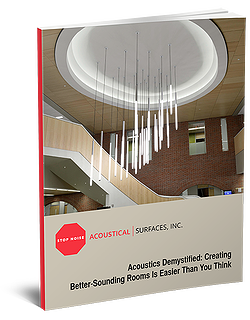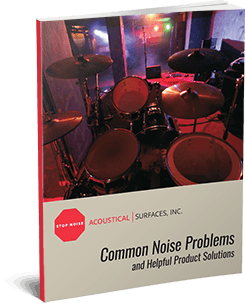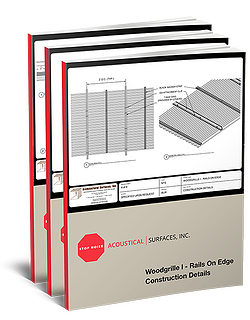Echo Reduction in Large Spaces: The Role of Acoustic Panels
Updated Feb 15, 2024
Most schools, businesses, and entertainment venues rely on large, multi-functional spaces to operate. In fact, large rooms are precious resources for organizations like these—the right-sized space can facilitate almost any purpose, whether it’s a high-stakes gathering of the board or a friendly game of pickleball.
But no matter how much utility these spaces provide, large rooms also come with unique challenges. Primarily, unwanted noise due to echo can create disturbances and diminished sound quality, harming the space’s productivity and accessibility. Fortunately, you can use industrial acoustic panels to reduce echo in large spaces—and we’re here to explain how.
The Challenge of Echo in Large Spaces
A 2022 BBC article reported that the acoustic properties of the spaces we spend time in—the home, the office, and public spaces—can impact our mental health. In particular, scientific research cited in the article suggests that noisy work settings can be an annoyance, and researchers have linked noise annoyance to depression and anxiety.1
Concentration prevention is another concern. Loud office or auditorium noises can disrupt thought patterns, interrupt concentration, and negatively impact performance.1
The last thing you want in your lecture hall is the conversation in the back row echoing loud enough to drown out the lecturer and be a distraction to others. In scenarios like this, acoustic panels can drastically reduce echo and improve sound quality. What Causes Echo?
In order to better understand how to reduce echo in a large room, we first need to understand everything about echo—primarily, what it is, where it comes from, and how large spaces especially are vulnerable to it.
Basics of Sound Waves
Echo is a product of how a sound wave travels. A sound wave is essentially a vibration we can register as it travels through air.
These vibrations result from the movement of molecules. Specifically, sound is a longitudinal wave, meaning the molecules vibrate back and forth parallel to the direction the sound energy travels rather than the perpendicular up-and-down vibration of a transverse wave.2
When a sound wave travels into a hard surface—such as a wall or the inside of a cave—it bounces back, essentially prolonging the vibration of the molecules. Although the direction of the sound changes, the echo can still resemble the original sound.
How Large Spaces Amplify Echo
In large, open spaces, sound waves have fewer opportunities to hit surfaces or objects that dampen or weaken them. So, when these sounds reflect off a hard wall, ceiling, or floor, they remain in movement, prolonging into an echo effect.
While solid and smooth surfaces reflect sound, soft materials absorb sound. For this reason, many sound-absorbing solutions harness soft substances like foam or polyester fabric. A perfect example of this science in action is the acoustic panel.
What Are Acoustic Panels?
Acoustic panels are a form of noise absorption technology that counter the natural properties of sound wave vibrations to create calmer, auditorily consistent spaces.
Definition and Types
Acoustic panels help maintain speech privacy and intelligibility in large spaces by reducing unwanted noise and reverberation. The main types of acoustic panels include diffusers, absorbers, and bass traps:
- Diffusers – Sound-diffusing acoustic panels manage noise levels by scattering or spreading sound waves. The goal of a diffuser is to distribute sound waves evenly for a balanced, consistent sound in any room.
- Absorbers – Sound absorption aims to actively reduce energy from sound waves to prevent reflection of sounds and flutter echo. Materials in sound-absorbing acoustic wall panels are usually soft, such as fabric, foam, and insulation. Reducing excess noise and reverberation can dramatically enhance the sound quality within a space.
- Bass Traps – Bass traps are specialized absorption wall panels designed to dampen the low-frequency soundwaves often found in nightclubs or concert venues. Bass traps are ideally placed in corners of rooms since bass waves can gather along wall joints.
To increase the versatility of acoustic panels even more, you can customize the materials within your panel to create different sound-mitigation capabilities to suit your space perfectly.
Materials Used
Three of the most commonly utilized materials in the construction of sound panels are wood, foam, and fabric. Here are the unique properties of each of them:
- Wood – Wood is an environmentally friendly, high-performance sound absorption material. Cementitious wood-fiber options like the Envirocoustic™ Wood Wool panels are highly effective at reducing sound transmissions and are thermally insulating as a bonus.
- Foam – Acoustical foam panel is a classic echo absorption solution. Foam is light and soft, lending to its flexibility and ease of installation in even tough-to-reach areas. For example, this flat-faced melamine foam absorbs a wide range of frequencies, is flat for increased surface absorption area, and is a Class A fire retardant.
- Fabric – Fabrics offer fantastic noise reduction quality and are highly customizable, lending to their viability as architecturally decorative pieces. Poly Max™ Acoustical Panels are a high-quality, stylish solution on which you can print your own graphics. You can also use fabric-wrapped wall panels to reduce noise and reverberation with an aesthetic flair.
How these materials work to soak up excess sound results from similar but slightly different sound absorption and sound diffusion processes.
How Do Acoustic Panels Reduce Echo?
Acoustic panels utilize either sound absorption or sound diffusion to restore balance to the auditory environment of your large room or space.
As we learned in describing acoustic panel types, sound absorption attempts to minimize the potency of sound waves. In contrast, sound diffusion transforms a harsh sound by redistributing it back into space at more even, mild frequencies.
Importance of Placement
Your placement strategy is crucial for maximizing the effectiveness of your acoustic panels. Ceilings or walls are the obvious first picks for panel installation. However, carefully examine your space and determine any non-negotiable obstacles like sprinkler systems or lighting fixtures that may limit your working space.
The room’s function and ideal aesthetic will also influence your placement. Something like a hanging ceiling cloud or baffles may work for your space theoretically but may be impractical in some settings or too visually distracting in others.
Once you’ve considered what type of acoustic panel you need and where you ideally want to place it, it’s time for perhaps the most crucial part of the process: installation.
Installation Tips
Installing a sound-absorbent or sound-diffusive acoustic ceiling or wall panel system in your space doesn’t have to be a complicated task. Here are some tips to consider when approaching the installation of your new acoustic treatment.
DIY vs Professional Installation
You may be pretty handy around your home or office when the doorknob comes loose or you need to hang a picture frame on the wall. Even so, you might not know the first thing about how to hang acoustic panels from ceilings or walls.
So, should you opt for professional installation or embrace the do-it-yourself mentality?
DIY will likely save costs, provided you approach the installation with patience and care. The good news is that wall or ceiling panels aren’t hard to install if you know what you’re doing. However, be advised that different sound-dampening panels have different methods of placement. Some require an adhesive, while others may use hardware or mounting systems, such as screws or impaling clips.
Teaming with a professional acoustics provider and installer is always a good idea if you want the security of knowing your sound-reducing solutions will function optimally. While this service might come at a premium, it can be worth the peace of mind, as well as the time saved.
Guidelines for Panel Spacing
When it comes to spacing your panels, there’s no one-size-fits-all answer for how far apart you should install them. However, there are some helpful guidelines you can follow to make panel positioning a breeze.
First, consider the purpose of your room, where the sound will likely come from, and the most likely position of the listener. You’ll generally want to position panels at first sound reflection points in the room, such as the side walls. However, evenly distributing your panels throughout the space can create a more consistent acoustical experience no matter your location in the room.
With this simple equation, you can determine how many panels you need and the minimum amount of square footage necessary to make a significant difference in the room’s sound quality:
- Cubic volume of the room x 3% = square footage of product
- Height x width x depth x 0.03 = Sq/Ft
Acoustic Panels in Large Spaces: Case Studies
To further illustrate the value and need for acoustic panels in large spaces, take a look at the following case studies where uncontrolled echo caused more harm than good:
- Cathedral of Girgenti, Sicily – Some large open spaces—particularly those with unique construction—have created humorous scenarios of unwanted eavesdropping. In one incident from 1824, a naval officer detailed a visit to a cathedral in Sicily where one man heard his wife vividly detailing her extramarital affair in a confessional booth from 250 feet away, thanks to the peculiar acoustics of the space.4
- Study of Acoustic Environment in Open Offices – A 2009 study of workers who moved from private offices to open-plan offices highlighted the need for acoustic regulation in shared office spaces. After the move, workers overwhelmingly self-reported losing work performance due to noisy conditions while distractions and concentration difficulties rose.5
While we may have better technology today than in 1824, acoustic issues with large spaces persist nearly 200 years later. Thankfully, Acoustical Surfaces is your one-stop shop for modern solutions to timeless acoustic dilemmas.
Professionally Equip Your Large Space with Acoustical Surfaces
If you need to increase comfort, reduce distraction, or otherwise upgrade the acoustic experience of your large space, trust the experts at Acoustical Surfaces to help you optimize your sonic landscape.
An industry leader in the latest techniques and knowledge of sound reduction and soundproofing practices, Acoustical Surfaces can analyze the unique properties of your space and recommend the most effective solutions.
Have problems with gym sounds? When you need to relieve your gymnasium, auditorium, or office space of echo and noise annoyances, give your resident experts at Acoustical Surfaces a call for professional support in choosing and installing acoustical panels of all functions and materials.
Sources:
- BBC. How the sound in your home affects your mood. https://www.bbc.com/future/article/20190729-how-the-sound-in-your-office-affects-your-mood
- Science World. Sound. https://www.scienceworld.ca/resource/sound/
- BBC. Reflection of sound waves. https://www.bbc.co.uk/bitesize/guides/z764t39/revision/3
- Slate. The Acoustics of Eavesdropping. https://slate.com/culture/2014/06/the-acoustics-of-eavesdropping-how-curved-ceilings-and-walls-redirect-and-amplify-sound.html
- PubMed. Effects of acoustic environment on work in private office rooms and open-plan offices – longitudinal study during relocation. https://pubmed.ncbi.nlm.nih.gov/19851909/






